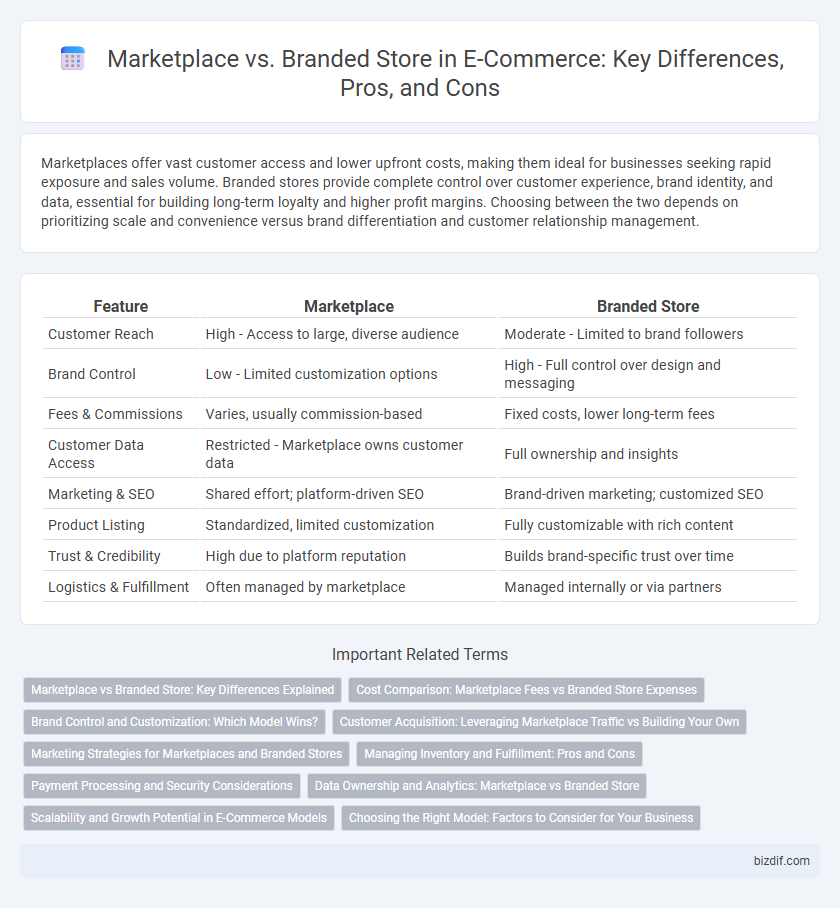Marketplaces offer vast customer access and lower upfront costs, making them ideal for businesses seeking rapid exposure and sales volume. Branded stores provide complete control over customer experience, brand identity, and data, essential for building long-term loyalty and higher profit margins. Choosing between the two depends on prioritizing scale and convenience versus brand differentiation and customer relationship management.
Table of Comparison
| Feature | Marketplace | Branded Store |
|---|---|---|
| Customer Reach | High - Access to large, diverse audience | Moderate - Limited to brand followers |
| Brand Control | Low - Limited customization options | High - Full control over design and messaging |
| Fees & Commissions | Varies, usually commission-based | Fixed costs, lower long-term fees |
| Customer Data Access | Restricted - Marketplace owns customer data | Full ownership and insights |
| Marketing & SEO | Shared effort; platform-driven SEO | Brand-driven marketing; customized SEO |
| Product Listing | Standardized, limited customization | Fully customizable with rich content |
| Trust & Credibility | High due to platform reputation | Builds brand-specific trust over time |
| Logistics & Fulfillment | Often managed by marketplace | Managed internally or via partners |
Marketplace vs Branded Store: Key Differences Explained
Marketplaces offer a vast range of products from multiple sellers, providing customers with extensive variety and competitive pricing, while branded stores focus exclusively on a single brand's inventory, ensuring consistent quality and brand loyalty. Marketplaces benefit from high traffic and diverse consumer bases but can dilute brand identity, whereas branded stores enable direct customer engagement and tailored marketing strategies to strengthen brand recognition. The choice between marketplace and branded store depends on business goals, whether prioritizing broad exposure or fostering deep customer relationships.
Cost Comparison: Marketplace Fees vs Branded Store Expenses
Marketplace platforms typically charge sellers fees ranging from 5% to 15% per transaction, including listing, referral, and payment processing fees, impacting overall profit margins. Branded stores require upfront investments in website development, hosting, marketing, and maintenance, which can be substantial but offer greater control over pricing and customer data. Over time, branded stores may result in lower variable costs compared to cumulative marketplace fees, making them more cost-effective for high-volume sellers.
Brand Control and Customization: Which Model Wins?
Branded stores offer superior brand control and customization, enabling businesses to tailor the user experience, design, and messaging to align perfectly with their brand identity. Marketplaces provide limited customization options and shared brand visibility, often diluting brand uniqueness due to standardized layouts and competing sellers. For companies prioritizing unique brand expression and full customer journey control, branded stores deliver a distinct advantage over marketplace models.
Customer Acquisition: Leveraging Marketplace Traffic vs Building Your Own
Marketplaces offer immediate access to vast, targeted customer traffic streams, accelerating customer acquisition through high visibility and trusted platform credibility. Branded stores enable long-term customer loyalty by creating personalized shopping experiences and capturing valuable first-party data for tailored marketing strategies. Leveraging marketplace traffic provides quick growth potential, while building your own store fosters sustainable customer relationships and brand equity.
Marketing Strategies for Marketplaces and Branded Stores
Marketplace marketing strategies emphasize broad audience reach, leveraging platform tools like sponsored listings, customer reviews, and dynamic pricing to boost product visibility and sales volume. Branded stores prioritize building customer loyalty through personalized content, exclusive promotions, and direct engagement via social media and email campaigns, enhancing brand identity and repeat purchases. Effective strategies for both involve optimizing SEO, data-driven targeting, and leveraging analytics to refine marketing efforts and maximize ROI.
Managing Inventory and Fulfillment: Pros and Cons
Marketplaces offer centralized inventory management and fulfillment services, reducing logistical complexity but often limiting control over stock levels and delivery standards. Branded stores provide complete oversight of inventory and fulfillment operations, enabling personalized customer experiences but requiring significant investment in warehousing and order processing infrastructure. Balancing inventory accuracy and fulfillment efficiency is crucial, with marketplaces excelling in scalability and branded stores offering brand consistency and customer loyalty benefits.
Payment Processing and Security Considerations
Marketplaces often provide integrated payment processing systems that offer convenience and streamlined transactions but may involve higher fees and less control over payment security protocols. Branded stores handle payment processing independently, allowing customized security measures such as PCI DSS compliance and advanced fraud detection tailored to the brand's specific customer base. Ensuring secure encryption methods like SSL/TLS and tokenization is critical in both models to protect sensitive financial data and build consumer trust in e-commerce environments.
Data Ownership and Analytics: Marketplace vs Branded Store
Branded stores enable full data ownership, providing detailed customer insights and control over analytics to tailor marketing strategies and optimize user experience. Marketplaces limit access to buyer data, restricting sellers' ability to analyze consumer behavior and personalize engagement effectively. Leveraging comprehensive analytics from branded stores fosters better decision-making and long-term customer relationship management.
Scalability and Growth Potential in E-Commerce Models
Marketplace platforms offer unparalleled scalability by aggregating multiple sellers and diverse product categories, enabling rapid expansion without significant inventory investments. Branded stores provide greater control over customer experience and branding, fostering stronger loyalty and higher lifetime value but may face slower growth due to limited product variety and audience reach. The choice between marketplace and branded store models must balance scalability benefits with long-term growth strategies tailored to specific market demands.
Choosing the Right Model: Factors to Consider for Your Business
Selecting between a marketplace and a branded store requires assessing factors such as target audience reach, control over branding, and cost structure. Marketplaces offer extensive exposure and streamlined logistics, while branded stores provide enhanced customer data ownership and brand consistency. Evaluating customer acquisition costs, long-term scalability, and marketing strategies determines the optimal e-commerce model for your business growth.
Marketplace vs Branded Store Infographic

 bizdif.com
bizdif.com